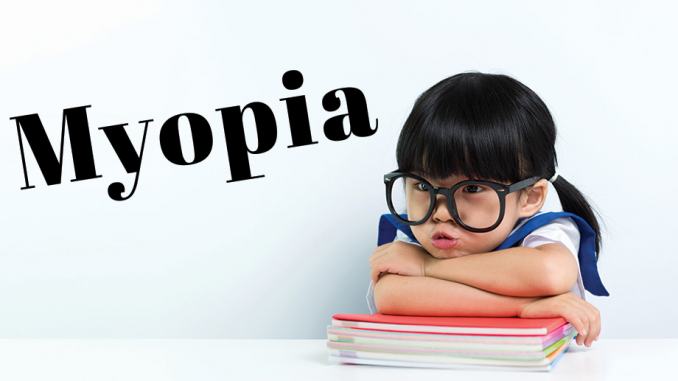By Andrea Zhao, RPh
In this day and age, we are making tremendous technological advances. Take a look around you now. Kids are spending way more time in front of screens than ever before. There has been talk about banning cell phones in the classroom because kids are so distracted by them! We now have iPads, smartphones, and flat screen televisions, all things I never had as a kid. I mean, I did not get my first cell phone until I was in university and it was a slide-out keyboard phone! While these technological advances are great, increased screen time may account partly for the increasing prevalence of nearsightedness (myopia) in kids.1 Research suggests that kids who spend more time outdoors in natural light and less time indoors in front of screens are less likely to develop myopia.1
Genetics is another risk factor increasing your child’s risk of myopia. The risk is higher if both parents are myopic compared to just one.2
Thankfully, there has also been progress made in the medical field and recently, it has been discovered that low-dose atropine eye drops (most commonly 0.01%) given at bedtime can significantly slow the worsening of myopia to severe myopia.
More good news? We can make these eye drops at Pace pharmacy!
How do you use them to derive the most benefit for your child, while limiting side effects?
- Use the eye drops regularly starting when myopia is first diagnosed. This is very important as progression of myopia is much quicker when your child’s eye is still rapidly growing throughout puberty. It usually tends to worsen quicker between the ages of 5 and 15, stabilizing by the time puberty is over.2
- Use the drops at bedtime (unless otherwise directed by prescriber). This helps to prevent any interruption of daily activities due to blurred vision which may be caused by the drops
- Discard after the beyond-use date written on the bottle. Ask your Pace pharmacist how long your drops are good for
- Keep the bottle IN THE FRIDGE
- Be careful not to allow the tip of the eye drop bottle to come into contact with any surface (including your child’s eye). This is to prevent contamination
- Give your Pace pharmacists a call a couple days before you need your child’s eye drops so that we can ensure it is ready for you on time. Conversely, we can also set up reminder calls in our system to call you
Frequently Asked Questions:
1. Is it necessary to use atropine eye drops for my child’s myopia?
If you notice your child’s myopia is severe enough to interfere with their education and/or daily activities, it should be treated. Pediatric myopia is treated with glasses. Your child will still require glasses as atropine eye drops do not reverse myopia. However, using atropine eye drops would be suitable for your child to help delay the progression of their myopia to much more severe myopia. This would help to decrease long-term eye complications such as retinal detachment, glaucoma, and cataracts in the future.3
2. How effective are these eye drops in slowing myopia progression in kids compared to other methods?
According to one review article, atropine eye drops are currently the most effective treatment for slowing the progression of myopia in kids.4 Another method of slowing progression of myopia in kids include corneal reshaping contact lenses, which can be thought of as analogous to braces for your teeth. These are like eye braces. Kids wear them daily overnight. They work by temporarily reshaping the cornea, allowing kids to be glasses and contact lenses-free during the day.5
3. What are the side effects of atropine eye drops?
The majority of kids experience little to no side effects. Aside from minor eye irritation (i.e. redness, itching) and blurred vision, there are no notable side effects to mention.
4. What is the cost of atropine eye drops?
Please contact us with your valid prescription and we would be happy to provide you with an accurate idea of how much this medication will cost.
5. What dose should my child be on?
The appropriate dose your child should be on will ultimately be determined by your child’s prescriber and depend on factors such as tolerability and effectiveness. We aim to have your child on the lowest tolerable, effective maintenance dose. 0.01% is a common initial starting dose. One randomized controlled trial compared the side effect and effectiveness profile of 0.5%, 0.1%, and 0.01% atropine and found that atropine 0.01% had minimal side effects compared to the higher strengths, while having a comparable effect on slowing myopia progression.6
6. How long does my child need to stay on these eye drops?
The optimal duration of treatment is unknown, however it is expected that your child be on these eye drops for a minimum of two years.4 Thereafter, your child’s eyes should be regularly monitored to ensure that the myopia does not worsen. If it does, treatment may need to be continued.4

References
1. Rauch, K. (31 August 2017). Low-Dose Atropine for Kids with Myopia. Retrieved from https://www.aao.org/eye-health/news/low-dose-atropine-kids-with-myopia
2. Tan, D. (1 June 2016). Childhood myopia and the use of atropine eye drops. Retrieved from https://www.ndcs.com.sg/news/patient-care/childhood-myopia-use-of-atropine-eye-drops
3. Heiting, G. (20 August 2018). Myopia control: Is there a cure for nearsightedness? Retrieved from https://www.allaboutvision.com/parents/myopia.htm
4. Wu, P.C., Chuang, M.N., Choi, J., Chen, H., Wu, G., Ohno-Matsui, K., Jonas, J.B., Cheung, C.M.G. (2018). Update in myopia and treatment strategy of atropine use in myopia control. Eye, 33(1), 3-13.
5. Coats, D.K., Paysse, E.A. (13 September 2018). Refractive errors in children. Retrieved from https://www.uptodate.com/contents/refractive-errors-in-children?sectionName=REFRACTIVE%20ERRORS&search=treating%20myopia%20in%20children&topicRef=5849&anchor=H3&source=see_link#H3

